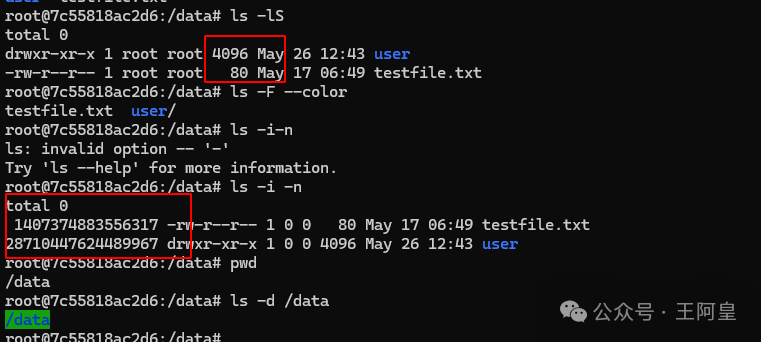Warm Reminder
If you like this article, please share it with your friends. If you have any questions or want more information, please follow or leave a message.
In Linux systems, managing files and directories is fundamental to daily operations. The <span>ls</span> command, as a common tool for listing the contents of files and directories, offers a rich set of parameter options to help users efficiently view and manage the file system. We have already introduced the basic usage of <span>ls</span>; this article will delve into the advanced parameters of the <span>ls</span> command and their functionalities, explained in detail with practical examples.
<span>ls</span> Command and Its Advanced Parameters Explained
-
Basic Usage
-
<span>ls</span>: Lists the files and directories in the current directory. -
<span>ls /path/to/directory</span>: Lists the files and directories in the specified directory.
Advanced Parameter Explanation
-
<span>-S</span>: Sorts files by size, displaying the largest files first. -
<span>-F</span>: Appends indicators to file names, such as<span>/</span>for directories and<span>*</span>for executable files. -
<span>--color</span>: Uses color to distinguish different types of files. -
<span>-i</span>or<span>--inode</span>: Displays the inode number of the file. -
<span>-n</span>or<span>--numeric-uid-gid</span>: Displays the file’s owner and group in numeric form instead of names. -
<span>-d</span>or<span>--directory</span>: Lists only the directory itself, not its contents.
Combined Parameters
-
<span>ls -lS</span>: Lists in long format sorted by file size. -
<span>ls -F --color</span>: Distinguishes file types by color and appends indicators to file names. -
<span>ls -i -n</span>: Displays the inode number and numeric owner and group of files. -
<span>ls -d</span>: Lists only the directory itself.
Code Examples
# Sort by file sizels-lS# Append indicators to file names and use color to distinguish file typesls-F–color# Display the inode number and numeric owner and groupls-i-n# List only the directory itselfls-d /data

Explanation of Code Examples
1. Sort by File Size
-
<span>ls -lS</span>: Lists in long format sorted by file size, with the largest files displayed first. For example, you can see a list of files sorted by size, making it easy to find large files.
2. File Name Indicators and Color Distinction
-
<span>ls -F --color</span>: Appends indicators to file names (e.g.,<span>/</span>for directories and<span>*</span>for executable files) and uses color to distinguish different types of files. This makes file types immediately clear.
3. Inode Number and Numeric Owner
-
<span>ls -i -n</span>: Displays the inode number and numeric owner and group of files. This is very useful for low-level file system operations and debugging.
4. List Only the Directory Itself
-
<span>ls -d /data</span>: Lists only the specified directory itself, not its contents. This is very convenient for checking if a directory exists or obtaining directory attributes.
Detailed Content Explanation
When using the <span>ls -l</span> command, the output includes detailed information about the files:
-
Inode Number (when using
<span>-i</span>): The inode number of the file, used to uniquely identify files in the file system. -
Numeric Owner and Group (when using
<span>-n</span>): Displays the file’s owner and group in numeric form instead of names.
Exercises
Exercise 1: Use the <span>ls -S</span> command to list the files in the current directory sorted by file size.
Exercise 2: Use the <span>ls -F --color</span> command to see the file type indicators and color distinction effects.
Exercise 3: Use the <span>ls -i -n</span> command to view the inode number and numeric owner and group of files.
Exercise 4: Use the <span>ls -d</span> command to list only the specified directory itself.
Exercise Answer Hints
Exercise 1: Run <span>ls -S</span> to list the files in the current directory sorted by file size, noting that the largest files are displayed first.
Exercise 2: Run <span>ls -F --color</span> to see the file type indicators and color distinction effects, for example, a directory name will show <span>/</span>, an executable file will show <span>*</span>, and different types of files will be displayed in different colors.
Exercise 3: Run <span>ls -i -n</span> to view the inode number and numeric owner and group of files, for example, you will see output like <span>123456 user_group user_group</span>.
Exercise 4: Run <span>ls -d /data</span> to list only the specified directory itself, not its contents.
Through this case study, you have mastered the advanced parameters of the <span>ls</span> command and its application scenarios, enabling you to manage and operate the Linux file system more efficiently. These skills will provide a solid foundation for your daily operations and development work in the Linux environment.
